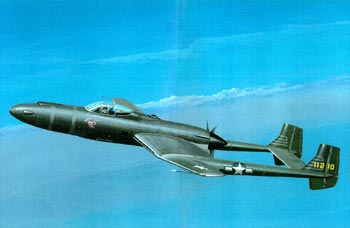
Nicknamed the ‘Swoose Goose’, the P-54 was a large aircraft but extremely slender. Siting high off the ground, the pilot was winched into the cockpit from below. The Vultee P-54 showed considerable potential, mainly on account of its high speed and awesome firepower. The nose section could be tilted to offset the drop of the low-velocity 37-mm cannon shells, but this feature did not function adequately.
The Vultee XP-54 or company Model 84, apart from being a twin-boom pusher, stood out for its sheer size, which made it by far the largest USAAF single-engine fighter of its time. The result of later thinking than the Bell XP-52 of similar layout, the twin-boom, single-seat, tricycle-gear XP-54 was ordered in late 1941 together with the closely related Curtiss XP-55 and Northrop XP-56. It was conceived for the /850-hp (1379.5-kW) Pratt & Whitney X-1800-A4G engine with contrarotating propellers, and early cancellation of the powerplant reduced the type’s performance and production prospects from the start. At the very time when the smaller but similarly-configured Swedish Saab 521 was taking shape, destined for widespread operational use, the XP-54 was prevented by an engine change from reaching its planned top speed of 5lOmph (820.7kmIh) and would not see squadron service.
Two prototypes (41-1210/1211) were built with minor structural differences, the first flown 15 January 1943 with the alternate 2,300-hp (1715.1-kW) Lycoming XH-2470, the first product by this manufacturer to power a USAAF fighter. The plan to install contra-rotating propellers was dropped.
Armed with two 37-mm cannon and two 0.5-in (12.7-mm) machineguns, the XP-54 was equipped with a nose section that could be tilted upward to ‘lob’ its low-velocity cannon shells at their target, while its machine-guns remained in depressed position. Another novel feature was a powered lift which raised the pilot into his cockpit 8ft (2.44m) off the ground. In an emergency bail-out, the pilot’s seat slid downward, a hinged panel protecting him from being hurled back into the pusher propeller. It is unclear whether protection from the forward airstream was adequate, but the arrangement was prophetic: it would not a pear again until the US Navy Douglas F-10 (F3Ds) Skyknight fighter of the 1950s.
The camouflaged first XP-54 (41- 1210) made 86 flights before being ferried to Wright Field, Ohio, on 28 October 1943 where only limited f u r t h e r t e s t s took place. The natural-metal second XP-54 (41- 1211) flew only once on a test hop from the manufacturer’s plant at Downey, California, to nearby Norton Field. Though the XP-54 showed awesome potential, the programme was discontinued after the tilting nose-gun section, dismantled from the airframe, was evaluated at Eglin Field, Florida. By late 1943, the time of innovation with propeller-driven fighters was nearing a close.
A further development of the XP-54 design the XP-68 Tornado, was canceled before construction could begin.
Specification XP-54
Type: single-seat fighter
Powerplant: one 2,300-hp (1715.1-kW) Lycoming XH-2470-1 24-cylinder liquid-cooled H-type piston engine driving a pusher four-blade propeller
Performance: maximum speed 403mph (648.5kmh) at 12,000ft (3658 ft); initial climb rate 2,300ft (701m) per minute; climb to 26,000ft (7925m) in 17.3 minutes; service ceiling 37,000ft (11278 m); range 500 miles (805 km)
Weights: empty 15,2621b (6922.8 kg); maximum take-off 19,3351b (8770.4kg)
Dimensions: span 53 ft 10 in (16.41 m); length 54 ft 9 in (16.69 m); height 13ft 0in (3.96 m); wing area 456sqft (42.36m2)
Armament: two 37-mm cannon and two 0.5-in (12.7-mm) machineguns in a ‘forward-firing installation